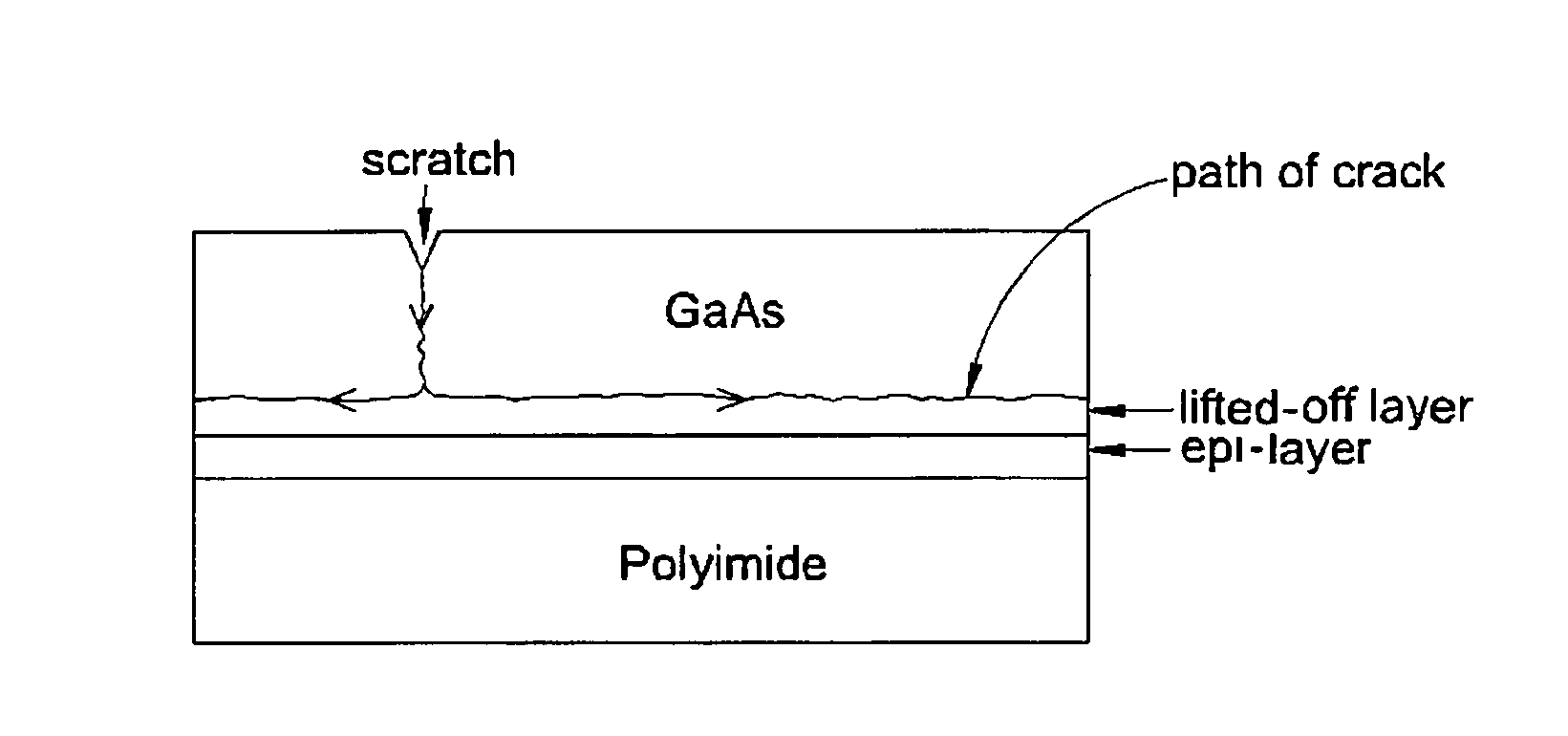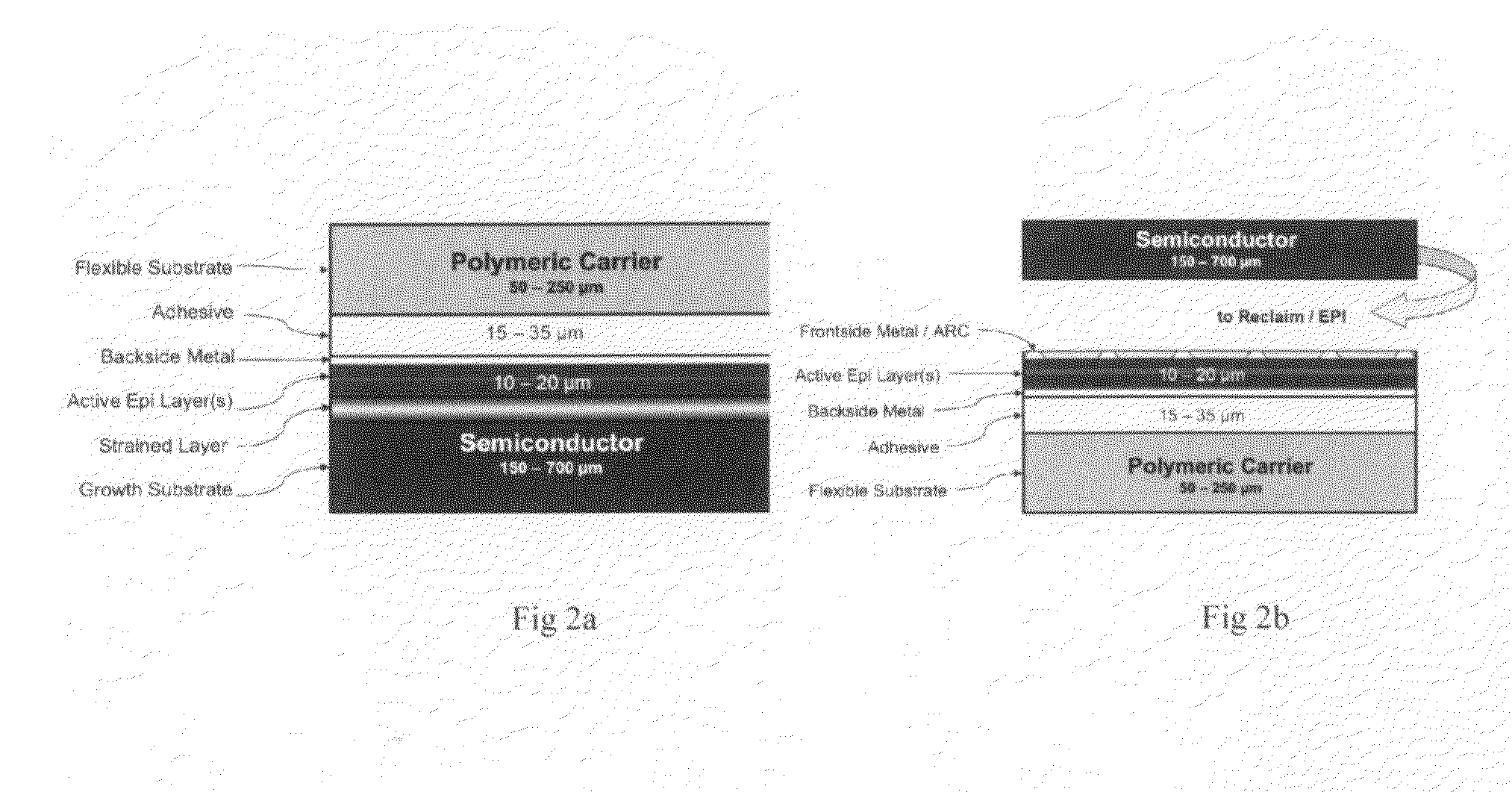Rapid Thinning of GaN and SiC Substrates and Dry Epitaxial Lift-off
- Summary
- Abstract
- Description
- Claims
- Application Information
AI Technical Summary
Benefits of technology
Problems solved by technology
Method used
Image
Examples
example 1
[0216]GaAs (110) E1eff=250 GPa, h1=370 μm, polyimide E2eff=5.8 GPa, h2=150 μm E=E1eff / E2eff=42.88, h=h1 / h2=2.467
[0217]Equations (5-9) yield:
1 / (2R)=0.3 m−1→R=1.66 m (10)[0218]σa1=6.75 MPa[0219]σa2=16.65 MPa[0220]σb1=27.75 MPa[0221]σb2=0.26 MPa[0222]εa1=0.27×10−4 [0223]εa2=28.7×10−4 [0224]εb1=1.20×10−4 [0225]εb2=0.48×10−4
example 2
[0226]Si (111) E1eff=300 GPa, h1=200 μm, polyimide E2eff=5.8 GPa, h2=150 μm E=E1eff / E2eff=51.3, h=h1 / h2=1.333
[0227]Equations (5-9) yield:
1 / (2R)=1 m−1→R=50 cm (11)[0228]σa1=11.4 MPa[0229]σa2=15.2 MPa[0230]σb1=59.6 MPa[0231]σb2=0.87 MPa[0232]εa1=0.38×10−4 [0233]εa2=26.2×10−4 [0234]εb1=2.0×10−4 [0235]εb2=1.5×10−4
[0236]As can be seen from the two examples above, the bending stress σb1 is larger than the axial stress σa1 for both GaAs and Si, i.e. the outer half of the wafer is under tension. Thus, the stresses are not exactly as depicted in FIGS. 45 and 49, rather as shown in FIG. 52. Points B1 and C1 are almost coincident and the neutral axis is actually very close to the centroid of the GaAs cross-section. The stress in the GaAs at the polyimide / GaAs interface is compressive, which helps prevent the crack from propagating at the interface. FIG. 52 depicts the stresses due to cooling below the temperature of zero stress. In the case of heating, the stresses are reversed, i.e. the po...
example 3
[0248]Referring back to Example 1 above, GaAs (110) full thickness h1=370 μm, polyimide h2=150 μm.
Uo=(0.0328+3.467+0.193+0.0003)bL=3.693 bL (18)
Uo=1 / 2{Fε1+Fε2+M1 / R+M2 / R}L (14)
Equation (14) is placed directly under equation (18) in order to compare the magnitudes of the corresponding terms. The largest contributor to the elastic strain energy at full thickness by far is the axial stress in the polyimide (1 / 2Fε2). The Kapton is being stretched by 28.7×10−4, followed by bending in the GaAs, then compression in the GaAs, followed by a distant fourth, bending in the Kapton. The amount of energy that goes in bending the GaAs is 18× smaller than that goes in stretching the Kapton. The majority of the energy (93%) at full thickness is stored in the Kapton.
PUM
| Property | Measurement | Unit |
|---|---|---|
| Length | aaaaa | aaaaa |
| Fraction | aaaaa | aaaaa |
| Fraction | aaaaa | aaaaa |
Abstract
Description
Claims
Application Information
 Login to View More
Login to View More - R&D
- Intellectual Property
- Life Sciences
- Materials
- Tech Scout
- Unparalleled Data Quality
- Higher Quality Content
- 60% Fewer Hallucinations
Browse by: Latest US Patents, China's latest patents, Technical Efficacy Thesaurus, Application Domain, Technology Topic, Popular Technical Reports.
© 2025 PatSnap. All rights reserved.Legal|Privacy policy|Modern Slavery Act Transparency Statement|Sitemap|About US| Contact US: help@patsnap.com



